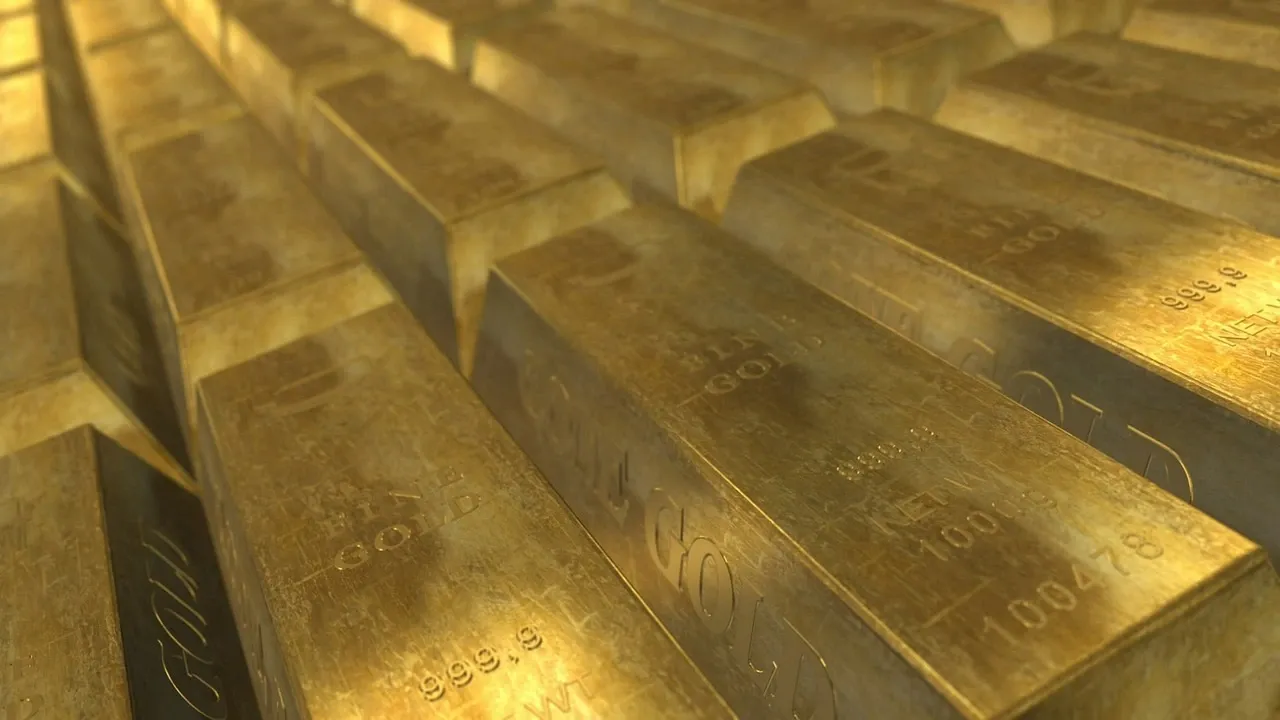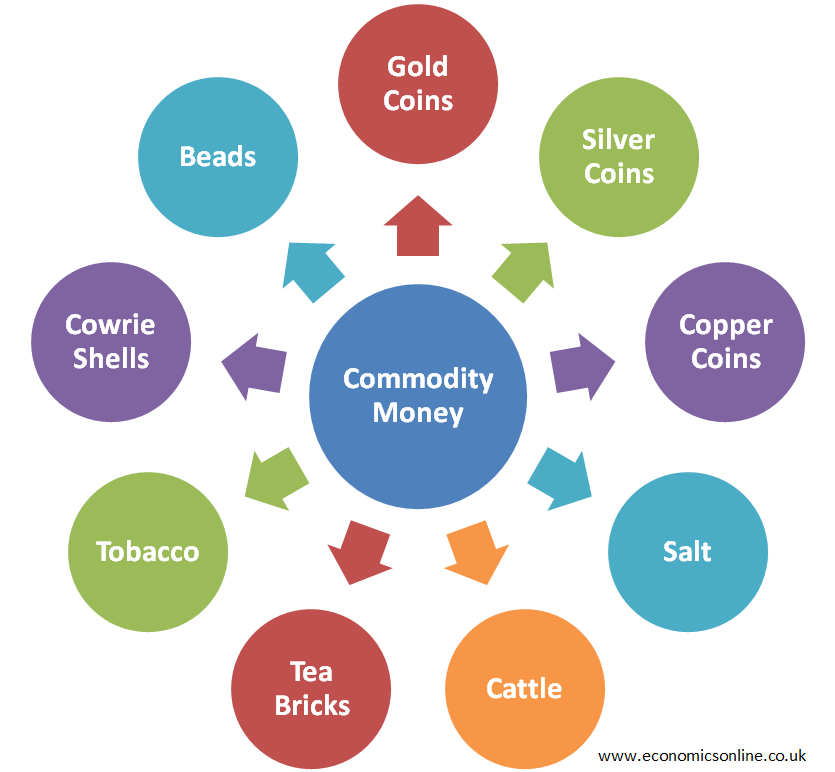
Commodity Money
What is the Commodity Money?
Commodity money is a type of money that has intrinsic value, meaning that its value is derived from the value of the commodity that it is made from. Examples of commodity money include gold coins, silver coins, and copper coins.
Intrinsic value refers to the inherent value that a commodity possesses, independent of its use as a medium of exchange. Commodity money, such as gold or silver, has intrinsic value because it has utility or usefulness in other applications beyond its use as money. For example, gold has intrinsic value because it is used in jewellery, electronics, and other industrial applications.
Basic Terms
Let’s define a few basic terms in order to better understand the concept of commodity money.
Barter Trade
The exchange of goods for goods is called barter trade. For example, exchange of wheat for firewood. There were some problems with the bartering system of trade, including the double coincidence of wants, the exchange rate, divisibility, perishability, and portability. Due to these problems with barter trade, people started using money.
Money
Due to the difficulties of barter trade, man developed a new medium of exchange, i.e., money. Money is defined as any item that is generally acceptable as a medium of exchange; it is used to buy goods and services. Anything can be considered money as long as it serves the functions of money, i.e., "money is what money does." There are four functions of money: a medium of exchange, a unit of account, a standard for deffered payments, and a store of value.
Money can be in the form of commodities like shells, cigarettes, or metals like copper, silver, and gold. Modern money comes in the form of paper or even plastic, like credit cards. Today, digital money like Bitcoin is also in use. Money enables the exchange of goods and services to take place more easily.
Legal Tender
Legal tender refers to the official currency that must be accepted as payment for settling debts in a particular country. It is an offence to refuse to accept legal tender. In other words, if a payment is made in a specific currency that is legal tender, that currency, by law, cannot be refused and must be accepted as payment. In most countries, legal tender is issued by a government or central bank and is backed by the full faith of the issuing authority.
Fiat Money
Fiat money refers to currency that is not backed by a physical commodity like gold or silver, but rather derives its value from the issuing government. It is the money issued by the central bank. The United States dollar is fiat money and is issued by the Federal Reserve Bank, which is the central bank of the United States.

History of the Commodity Money
The history of commodity money dates back to ancient times, when humans used a variety of objects as a medium of exchange. These objects included shells, beads, and other small items that were easy to carry and were universally recognised as valuable.
The first standardised commodity money was created in ancient Mesopotamia around 2500 BCE. These coins were made from metals like gold and silver and stamped with the image of a ruler or other symbol to indicate their value.
Over time, other civilizations began to develop their own forms of commodity money. The ancient Greeks used coins made from precious metals. In medieval Europe, coins were issued by individual monarchs and feudal lords.
During the Age of Exploration in the 15th and 16th centuries, European nations began to establish colonies in the Americas, Africa, and Asia, leading to the development of global trade networks. This led to the emergence of international currencies like the Spanish dollar and the Dutch guilder.
In the 20th century, most countries moved away from using precious metals like gold and silver to back their currencies and instead began using fiat currency, which is not backed by a physical commodity but rather by the government that issues it.
Other Types of Money
Paper Money
Paper money has its origins in the receipts issued by goldsmiths to customers who deposited their money and other valuables with them for safekeeping. The receipts were issued in smaller units. This gave rise to bank notes. Today, we use paper money, i.e., dollars or rupees.
Bank Money
Bank money refers to current account or demand deposit that is transferable through the use of cheques. It is very important to note that demand deposits or bank deposits, are considered money but not cheques. A cheque is merely an order from the owner to the banker to transfer his money to someone else.
Plastic Money
Plastic money is in the form of credit cards such as Master Card and Visa.
Digital Money
Digital money is the form of money that is stored and exchanged electronically. Cryptocurrency is one form of digital money. The first and most well-known cryptocurrency is Bitcoin, which was created in 2009. Since then, thousands of other cryptocurrencies have been developed, each with their own unique features and purposes.
Understanding the Commodity Money
Commodity money is a type of money that has intrinsic value because it is made from a valuable commodity such as gold, silver, or other commodities. It works as a medium of exchange and its value is determined by the weight and purity of the commodity from which it is made.
Commodity money has been used throughout history, and its use can be traced back to ancient civilizations where it was used to facilitate trade and commerce. The underlying commodity gives the currency its inherent value, and its limited supply helps to stabilize its value over time.
Commodity money works by relying on the value of the underlying commodity. For example, if a gold coin weighs one ounce and the current market price of gold is $1,500 per ounce, then the value of the coin would be $1,500. If the market price of gold were to increase, the value of the gold coin would increase as well. Conversely, if the market price of gold were to decrease, the value of the gold coin would decrease as well.
Examples of the Commodity Money
Here are some examples of commodity money:

Gold Coins
Gold has been used as a form of commodity money for centuries. Gold coins were first used in ancient Greece and Rome and were later used in many countries until the 20th century.
Silver Coins
Like gold, silver coins have also been used as a form of commodity money. The Spanish dollar is a famous example of a silver coin used as currency.
Copper Coins
While not as valuable as gold or silver, copper coins have also been used as a form of commodity money in some countries.
Salt
In ancient times, salt was a highly valued commodity that was used as a form of money in some cultures.
Cattle
In some African societies, cattle have been used as a form of commodity money.
Tea Bricks
In ancient China, tea bricks made from compressed tea leaves were used as a form of commodity money.
Tobacco
In colonial America, tobacco was used as a form of currency.
Cowrie Shells
Cowrie shells were used as currency in many parts of the world, including ancient China, India, and Africa.
Beads
Beads made from various materials, including shells, glass, and stone, have been used as a form of commodity money in many cultures.
These are just a few examples of the many forms of commodity money that have been used throughout history. Other examples are alcohol, cigarettes, cocoa beans, barley, wheat, large stones, silk, and the list goes on.
Characteristics of the Commodity Money
Commodity money has several characteristics that distinguish it from other types of currency.
Intrinsic Value
Commodity money has intrinsic value because it is made from a valuable commodity such as gold, silver, or other precious metals. This gives the currency an inherent worth beyond its use as a medium of exchange, which makes it desirable and valuable.
Durability
Commodity money is durable and can withstand wear and tear. Precious metals like gold and silver are resistant to rust and corrosion, which ensure that they retain their value or purchasing power over time. This makes them an excellent store of value and a reliable means of exchange.
Portability
Commodity money is portable and easily transportable, which makes it convenient for use in trade and commerce. Gold and silver coins, for example, are small and lightweight, which means they can be easily carried and transported from one place to another.
Divisibility
Commodity money is divisible into smaller units to facilitate transactions of varying sizes. For example, a gold coin can be broken down into smaller units, such as grams or ounces, to make it easier to buy and sell smaller items.
Fungibility
Commodity money is fungible, meaning that each unit of the currency is interchangeable with any other unit of the same type and value. This makes it easy to exchange and trade, as there is no need to distinguish between individual units of the same currency.
Advantages of the Commodity Money
Intrinsic Value
Commodity money has intrinsic value, which means it has inherent worth beyond its use as a medium of exchange. This gives it greater stability and security than fiat money, which is not backed by any tangible assets.
Limited Supply
Commodity money has a limited supply because it is made from a finite resource such as gold or silver. This ensures that value of money is not subject to the same level of inflationary pressures as fiat money, which can be printed without limit.
Store of Value
Commodity money is an excellent store of value because it is durable and retains its value over time. This makes it a reliable means of preserving wealth and protecting against inflation.
Disadvantages of the Commodity Money
Difficult to Transport and Store
One of the main disadvantages of commodity money is that it can be difficult to transport and store. Precious metals like gold and silver are heavy and can be cumbersome to transport and store. This can make it difficult to use commodity money in large transactions.
Lack of Flexibility
Commodity money can be inflexible because its value is tied to the commodity from which it is made. This means that it cannot be easily adjusted to accommodate changes in the economy or meet the needs of consumers.
Costly to Produce
Commodity money can be expensive to produce because it requires the mining and refining of precious metals such as gold and silver. This can make it a less attractive option than fiat money, which can be printed at a much lower cost.
Security Concerns
Commodity money can be vulnerable to theft and fraud because it is a tangible asset. This can make it less secure than digital forms of currency, which can be more easily protected through encryption and other security measures.
Conclusion
Commodity money is a type of money that has intrinsic value based on the underlying commodity or material that it is made from. While commodity money has some advantages over fiat money, such as protection against inflation, it also has some disadvantages, such as the difficulty of transporting and storing physical commodities. Despite these challenges, commodity money has been used throughout history and continues to be used in some form today.

